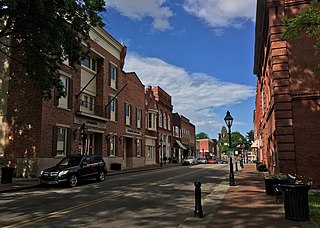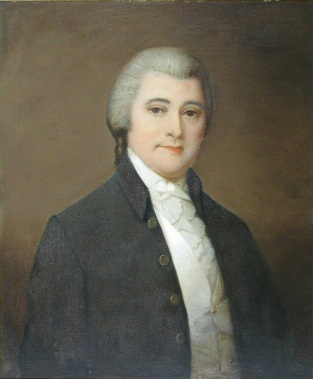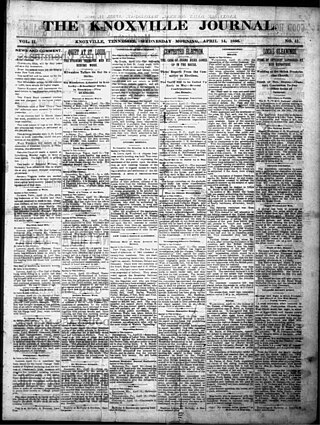Related Research Articles

Rogersville is a town in, and the county seat of, Hawkins County, Tennessee, United States. It was settled in 1775 by the grandparents of Davy Crockett. It is named for its founder, Joseph Rogers. Tennessee's second oldest courthouse, the Hawkins County Courthouse, first newspaper The Knoxville Gazette, and first post office are all located in Rogersville. The Rogersville Historic District is listed on the National Register of Historic Places.

William Blount was an American politician, landowner and Founding Father who was one of the signers of the Constitution of the United States. He was a member of the North Carolina delegation at the Constitutional Convention of 1787 and led the efforts for North Carolina to ratify the Constitution in 1789 at the Fayetteville Convention. He then served as the only governor of the Southwest Territory and played a leading role in helping the territory gain admission to the union as the state of Tennessee. He was selected as one of Tennessee's initial United States Senators in 1796, serving until he was expelled for treason in 1797.

The Tennessean is a daily newspaper in Nashville, Tennessee. Its circulation area covers 39 counties in Middle Tennessee and eight counties in southern Kentucky. It is owned by Gannett, which also owns several smaller community newspapers in Middle Tennessee, including The Dickson Herald, the Gallatin News-Examiner, the Hendersonville Star-News, the Fairview Observer, and the Ashland City Times. Its circulation area overlaps those of the Clarksville Leaf-Chronicle and The Daily News Journal in Murfreesboro, two other independent Gannett papers. The company publishes several specialty publications, including Nashville Lifestyles magazine.

The Territory South of the River Ohio, more commonly known as the Southwest Territory, was an organized incorporated territory of the United States that existed from May 26, 1790, until June 1, 1796, when it was admitted to the United States as the State of Tennessee. The Southwest Territory was created by the Southwest Ordinance from lands of the Washington District that had been ceded to the U.S. federal government by North Carolina. The territory's lone governor was William Blount.

The Holston Formation, alternately known as the Holston Limestone, is a stratigraphic unit of Ordovician age within the Chickamauga Group in the Ridge-and-Valley physiographic province of the southeastern United States. A 120-mile (190 km) long outcrop belt of the Holston in East Tennessee is the source of the decorative building stone known as Tennessee marble.

U.S. Route 11W (US 11W) is the western branch of US 11 from the twin cities of Bristol, Tennessee/Bristol, Virginia, where US 11 splits into US 11E and US 11W, to Knoxville, Tennessee, where the two highways rejoin. The highway serves the Appalachia region's Ridge-and-Valley section of East Tennessee, bounded by the Clinch Mountain ridge to the north and the Holston River to the south. US 11W from Bristol to Bean Station and Blaine to Knoxville are designated as part of the National Highway System.

The Knoxville Gazette was the first newspaper published in the U.S. state of Tennessee and the third published west of the Appalachian Mountains. Established by George Roulstone (1767–1804) at the urging of Southwest Territory governor William Blount, the paper's first edition appeared on November 5, 1791. The Gazette provided an important medium through which Tennessee's frontier government could dispense legislative announcements, and the paper's surviving editions are now an invaluable source of information on life in early Knoxville.

Statesview, or States View, is a historic house located on South Peters Road off Kingston Pike in Knoxville, Tennessee, United States. Built in 1805 by Knoxville architect Thomas Hope and rebuilt in 1823 following a fire, Statesview was originally the home of surveyor Charles McClung. Following McClung's death, newspaper publisher Frederick Heiskell purchased the house and estate, which he renamed "Fruit Hill." The house is listed on the National Register of Historic Places for its architecture and political significance.
This is a list of the National Register of Historic Places listings in Knox County, Tennessee.
The East Tennessee Historical Society (ETHS), headquartered in Knoxville, Tennessee, United States, is a non-profit organization dedicated to the study of East Tennessee history, the preservation of historically significant artifacts, and educating the citizens of Tennessee. The society operates a museum and museum shop in the East Tennessee History Center on Gay Street in downtown Knoxville. The East Tennessee Historical Society was established in 1834, 38 years after the establishment of the state of Tennessee, to record the history of the development and settlement of the area.

Amis House is a pioneer settlement in Hawkins County, Tennessee near Rogersville, built in 1780–2 by Thomas Amis, the father-in-law of Rogersville founder Joseph Rogers.

Q-Notes is a lesbian, gay, bisexual and transgender (LGBT) newspaper serving North Carolina and South Carolina. It is based in Charlotte, North Carolina. Published every other week, it has a circulation of 11,000 print copies and is the largest print publication serving the LGBT community in the American Southeast. The paper traces its origins to the monthly newsletter of the Queen City Quordinators, a Charlotte LGBT organization, which they began publishing in 1983. In 1986, Qnotes changed to a monthly tabloid. In 2006, it merged with the Raleigh, N.C. LGBT newspaper The Front Page.
The Beaverton Valley Times, also known as the Valley Times, is a weekly newspaper covering the city of Beaverton, Oregon, United States, and adjacent unincorporated areas in the northern part of the Tualatin Valley. Owned since 2000 by the Pamplin Media Group, the paper was established in 1921. Currently based in neighboring Portland, the Valley Times is printed each Thursday.

Tennessee marble is a type of crystalline limestone found only in East Tennessee, in the southeastern United States. Long esteemed by architects and builders for its pinkish-gray color and the ease with which it is polished, this stone has been used in the construction of numerous notable buildings and monuments throughout the United States and Canada, including the National Gallery of Art and the National Air and Space Museum in Washington, D.C., the Minnesota State Capitol, as well as parts of the United States Capitol in Washington, Grand Central Terminal in New York, and Union Station in Toronto. Tennessee marble achieved such popularity in the late-19th century that Knoxville, the stone's primary finishing and distribution center, became known as "The Marble City."
The Knoxville Register was an American newspaper published primarily in Knoxville, Tennessee, during the 19th century. Founded in 1816, the paper was East Tennessee's dominant newspaper until 1863, when its pro-secession editor, Jacob Austin Sperry (1823–1896), was forced to flee advancing Union forces at the height of the Civil War. Sperry continued to sporadically publish the Register in Atlanta, and later Bristol, until he was finally captured by Union forces in December 1864.
Blount Today was a weekly newspaper based in Maryville, Tennessee, covering Blount County, Tennessee. It was part of the Scripps Interactive Newspapers Group.

Frederick Steidinger Heiskell was an American newspaper publisher, politician, and civic leader, active primarily in Knoxville, Tennessee, throughout much of the 19th century. He cofounded the Knoxville Register, which during its early years was the city's only newspaper, and operated a printing firm that published a number of early important books on Tennessee history and law. He also served one term in the Tennessee Senate (1847–1849), and briefly served as Mayor of Knoxville in 1835. He was a trustee, organizer, or financial supporter of numerous schools and civic organizations.
Adams Publishing Group LLC(APG) is a company that provides publishing services, including newspapers, periodicals, and website publishing in the United States. Its corporate headquarters is located in Coon Rapids, Minnesota. Mark Adams, the son of Stephen Adams, founded Adams Publishing Group in late 2013. In March 2014, APG began to acquire newspapers and media related businesses. As of 2022, it owned more than 127 newspapers in 20 states and the District of Columbia.

The Knoxville Journal was a daily newspaper published in Knoxville, Tennessee, United States, between 1886 and 1991. It operated first as a morning and then as an afternoon publication.
References
- ↑ "APG Regional Maps with-Circulation: Tennessee" (PDF). adamspg.com. 2019-12-01. Retrieved 2023-04-25.